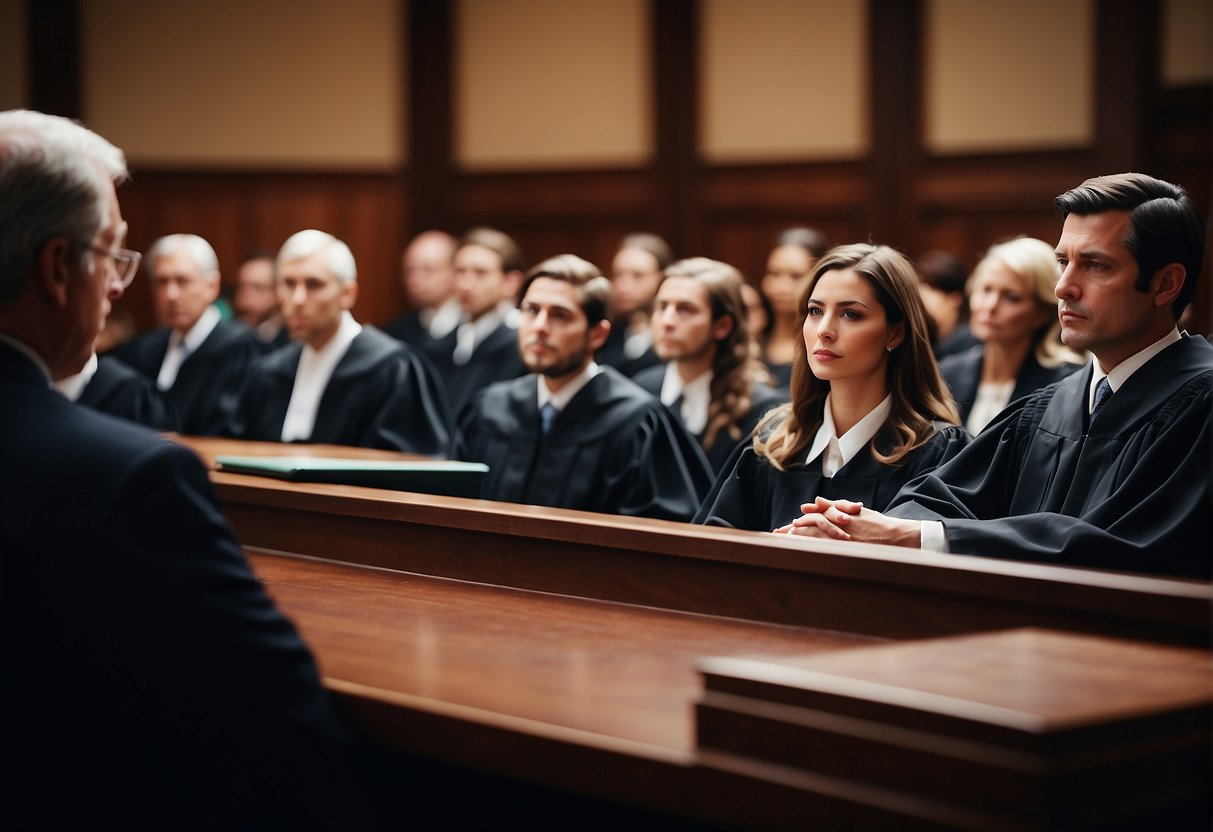Understanding Personal Injury Law

Personal injury law is integral to ensuring that individuals who suffer harm due to another’s actions or negligence can pursue compensation. We’ll delve into its key components and the legal framework that underpins claims.
Fundamentals of Personal Injury
Personal injury law defines legal rights and remedies for those injured physically or emotionally due to another party’s negligence or harmful acts. At its core, this body of law is designed to provide justice and compensation for harm suffered. Claims must establish liability, which hinges on proving negligence or intent. Critical elements we must establish in a personal injury case include:
- Duty of Care: The defendant owed a legal duty to the plaintiff.
- Breach: There was a breach of this duty.
- Causation: The breach caused the injury.
- Damages: The injury resulted in compensable damages.
Tort Law: The Basis for Claims
Tort law serves as the foundation for personal injury claims, encompassing wrongs and damages leading to civil legal liability. Within this framework, torts are generally classified as:
- Intentional Torts: These occur when an individual intentionally causes harm, such as assault or battery.
- Negligence Torts: Most personal injury cases fall under this category where harm results from a failure to exercise reasonable care.
- Strict Liability Torts: Liability is established without the need to prove negligence or fault, typically in cases involving inherently hazardous activities.
Tort law operates under statutes and common law, with statutes providing specific parameters and common law drawing upon prior court decisions to guide case outcomes. Personal injury laws vary by jurisdiction but the underlying principles of justice and compensation remain consistent across the legal framework.
The Claims Process
In this section, we outline the crucial steps involved in the claims process for personal injury cases, focusing specifically on insurance’s role, how to file, and the proper management of evidence.
The Role of Insurance in Personal Injury Claims
Insurance companies play a pivotal role in personal injury claims, often being the entities from which compensation is sought. Initially, the injured party files an insurance claim against the at-fault party’s insurance provider. It’s our task to notify the insurer as soon as possible to commence the claim. Proper documentation of the injury and associated costs is vital as these details are used to determine the claim’s value.
- Notify the Insurer: Contact the insurance company to report the incident.
- Claim Review: The insurer reviews the claim to assess liability and damages.
- Negotiation: There may be a back-and-forth negotiation to reach a fair settlement with the insurance adjuster.
Stages of Filing a Personal Injury Claim
Filing a personal injury claim is a multi-stage process, from the initial lodging of the claim to potentially reaching a settlement. Below is a simplified roadmap:
- Consultation with Personal Injury Attorney: We seek legal advice to navigate the complexities of the claims process.
- Incident Documentation: Gathering all pertinent information related to the incident, injury, and subsequent costs.
- Filing the Claim: Officially lodging the claim with the relevant parties.
- Negotiation/Mediation: Engaging in discussions to reach a settlement agreement.
- Litigation: If necessary, taking the claim to court.
Gathering and Presenting Evidence
Solid evidence is foundational to a strong personal injury claim. We emphasize meticulous gathering and presenting evidence to support the legal claim. This includes:
- Medical Records: We collect all medical documentation relating to injuries.
- Incident Reports: Official reports or witness statements that substantiate the occurrence of the incident.
- Financial Records: We compile proof of lost wages and other expenses incurred due to the injury.
Ensure Evidence Integrity: All gathered evidence must be credible and directly related to the incident and the incurred damages.
Legal Representation and Advice
When involved in a legal matter due to an injury, securing competent legal representation and advice is crucial. We guide you through choosing a personal injury lawyer, understanding the significance of legal advice, and knowing about legal fees.
Choosing the Right Personal Injury Lawyer
To begin selecting a personal injury attorney, consider their experience and track record. It’s essential that they specialize in personal injury law, as this field requires specific skills and knowledge.
- Ask about past cases: How many have they won?
- Look for testimonials: What do previous clients say?
- Confirm their credentials: Are they licensed and in good standing?
Remember, the right attorney can make a substantial difference in the outcome of your case.
The Importance of Legal Advice
Acquiring legal advice from a knowledgeable personal injury lawyer is vital. It ensures that you are fully aware of your rights and the legal processes involved in your case. Here’s why professional advice is essential:
- Understanding your case: Your attorney can explain complex legal terms and procedures.
- Navigating the system: Legal systems can be intricate and overwhelming. Your lawyer is your navigator.
Do not underestimate the value of expert insight. It can often be the determining factor in the success of your claim.
Understanding Legal Fees
Legal fees can be mystifying, but we’ll make them clearer for you. Personal injury lawyers typically work on a contingency fee basis. This means you’re not paying any upfront costs. Instead, their fee is a percentage of your settlement or court award, usually around 25% to 40%.
- No win, no fee: If you don’t win the case, you generally owe nothing.
- Discuss expenses: Understand what other legal costs (like filing fees) might arise.
Always ensure fee structures and terms are transparent prior to securing legal services to avoid any surprises.
Specific Types of Personal Injury Cases
Personal injury law covers a vast array of incidents where individuals sustain harm due to the actions or negligence of another entity. We’ll explore key categories including vehicle-related injuries, medical malpractice, and product liability.
Vehicle-related Injuries and Accidents
Car Accidents: These are one of the most common personal injury claims. If we are involved in a car accident due to someone else’s negligence, we may be entitled to compensation for our injuries. Typical causes include speeding, distraction, and failure to obey traffic laws.
- Common injuries include:
- Whiplash
- Broken bones
- Head and spinal injuries
Slip and Fall Accidents: These cases often occur on another person’s property. Property owners have a duty to keep their premises safe. Failure to do so, resulting in a slip and fall incident, can lead to claims of negligence.
- Factors in these cases may include:
- Wet floors
- Uneven surfaces
- Poor lighting
Medical Malpractice and Negligence
Medical Malpractice: Occurs when health care professionals fail to provide the standard of care that a competent professional would. If we suffer harm due to medical negligence, we could have grounds for a claim.
- Examples of malpractice include:
- Misdiagnosis
- Surgical errors
- Medication mistakes
Negligence: Medical personnel are expected to avoid causing harm. Negligence occurs when there’s a breach of their duty of care. Injuries from such negligence warrant seeking legal redress.
- Negligent actions can involve:
- Ignoring patient history
- Failing to order appropriate tests
- Not acting on test results promptly
Product Liability and Defective Products
Defective Product: If we are injured by a product that is defective, we may pursue a product liability claim against the manufacturer or seller.
- Types of defects can include:
- Design flaws
- Manufacturing defects
- Inadequate instructions or warnings
Product Liability: This legal concept holds manufacturers, distributors, suppliers, retailers, and others who make products available to the public responsible for the injuries those products cause.
- Liability can stem from:
- Failure to test a product adequately
- Not following quality control procedures
- Misleading marketing practices
Each personal injury case type has specific legal standards, processes, and types of compensation available to injured individuals. Car accidents, slip and fall accidents, medical malpractice, negligence, defective products—all these scenarios can profoundly impact lives, and understanding our legal rights in these situations is crucial for seeking justice and compensation.
Compensation and Damages
In addressing compensation and damages, we focus on the financial restitution available to individuals who have sustained injuries. This encompasses compensatory damages for actual losses, and in certain cases, punitive damages intended to punish egregious conduct.
Calculating Compensatory Damages
Compensatory damages are intended to cover all the financial losses an injured party has experienced. These typically include:
- Medical expenses: Immediate and ongoing medical treatment costs.
- Lost wages: Compensation for time off work due to injury.
- Property damage: Cost of repairing or replacing property.
The calculation is generally straightforward, summing actual expenses incurred and projecting future costs related to the injury.
Non-Economic Damages: Pain and Suffering
Non-economic damages account for the more intangible impacts of an injury, such as:
- Pain and suffering: Physical discomfort and distress.
- Emotional distress: Psychological impact, which might include anxiety, depression, and loss of enjoyment of life.
These are more subjective and typically require a detailed analysis of the injured individual’s life and how it has been altered by the injury.
Pursuing Punitive Damages
Punitive damages are less common and are not tied to the specific losses suffered by the injured party. They are awarded where the defendant’s conduct was:
- Especially harmful: Showing a disregard for the health and safety of others.
- Intentional or grossly negligent: Beyond ordinary negligence, indicating a higher level of fault.
These serve as a deterrent and are decided by the court system, rather than an exact calculation based upon the damages incurred.




